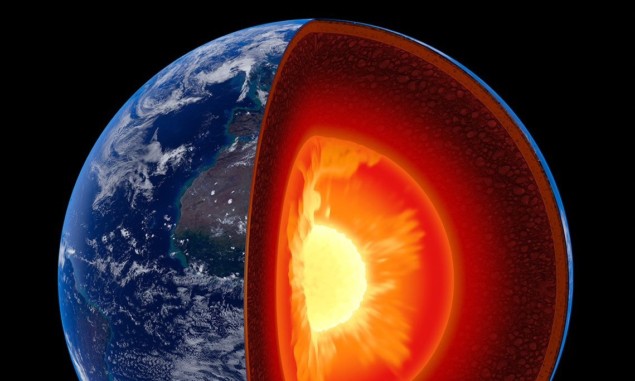November 2, 2021

Core of the matter: can elements be synthesized deep within the Earth? (Courtesy: Shutterstock/Johan Swanepoel)
Creating elements lighter than iron might not require the extreme conditions found inside very massive stars. According to a group of physicists in Japan and Canada, it is possible that oxygen, nitrogen and all other elements with atomic numbers up to 25 have also been produced inside the Earth. Their eye-catching claim relies on the idea that fusion reactions occur in the Earth’s lower mantle, where they are catalyzed by neutrinos and excited electrons.
According to the Big Bang model, the only elements present in the early universe were hydrogen, helium and tiny amounts of lithium. It is thought that elements with atomic numbers between four (beryllium) and 25 (manganese) are instead made through the progressive fusion of heavier nuclei inside massive stars. This process comes to a halt because the generation of iron (atomic number 26), in contrast with that of lighter elements, does not give off excess energy and so is unable to prevent stars from collapsing under their own weight. The resulting supernovae, however, yield high-speed neutrons that are captured by nuclei to create elements heavier than iron.
In the latest work, Mikio Fukuhara of Tohoku University and colleagues in Japan and Canada propose that these lighter elements can also be produced deep inside the Earth. The inspiration for this idea comes from the evolution of Earth’s atmosphere. As the researchers point out, the atmosphere is thought originally to have been made up almost exclusively of carbon dioxide. But its composition then changed radically, resulting in the dominance of nitrogen – which today accounts for about 78% of the molecules in the atmosphere – as well as large amounts of oxygen (some 21%), while carbon dioxide is a mere 0.2%.
Accumulation of nitrogen-14
Many scientists, says Fukuhara, reckon that much of the nitrogen was contained in material from the solar nebula, a gaseous cloud that condensed and conglomerated to form the Sun and its planets. Additional nitrogen then came as planetesimals rich in the element crashed into our planet. But he argues that that hypothesis cannot explain the rapid accumulation of nitrogen-14 which is thought to have taken place between 3.8–2.5 billion years ago.
The answer, Fukuhara reckons, might be terrestrial nuclear fusion. In a model published last year, he proposed that nitrogen, oxygen and water – whose concentration has also shot up over time – could have been forged in endothermic reactions inside the Earth’s mantle. Those reactions would involve carbon and oxygen nuclei confined inside the crystal lattice of calcium carbonate rocks.
As he pointed out, even the very high temperatures and pressures at depths of several thousand kilometres would not be enough to force those nuclei together against their mutual repulsion. But he claims that the presence of subatomic particles known as neutral pions can increase the nuclear attraction to the point where fusion occurs. Those pions, he says, would be generated by electrons excited by the rapid fracturing and sliding of carbonate crystals – caused by volcanic eruptions. Alongside the excited electrons would be neutrinos, captured as they stream through the Earth in large numbers from the Sun or other stars, or alternatively from nuclear reactions in the Earth’s core.
The latest work builds on this research by showing how such catalyzed fusion reactions could explain the production not only of nitrogen, oxygen and water, but all of the 25 lightest elements. To demonstrate the plausibility of this mechanism, the researchers calculated the minimum energy required to initiate the reaction in each case and then analysed the crystal structure of a mineral found in the mantle that contains the reacting elements.
Temperature, pressure and catalysis
As they report in a paper published in AIP Advances, they carried out the latter part of the analysis for three sets of nuclei – magnesium and iron, aluminium and magnesium, and aluminium and silicon. In all three cases they concluded that the combination of temperature, pressure and catalysis would indeed reduce the interaction distance between the nuclei such that they could fuse – yielding sulphur and titanium, sodium and silicon, and oxygen and potassium, respectively.
Isotope ratios yield clues to element synthesis
Fukuhara and colleagues point out that their proposed fusion mechanism remains a hypothesis and should be put to the test in experiments carried out at high temperatures and pressures. But they maintain that if confirmed their results would have a profound impact on geophysics. “To the best of our knowledge,” they write, “theories of element creation have not been previously developed in the context of an ‘Earth factory’”.
They add that they are performing additional calculations to work out whether the mechanism they have identified also applies to elements heavier than iron. Plus, they hint at a possible application of their work, arguing it offers the potential to create elements needed for space exploration. “We need not to look for oxygen, water and other elements in planets and satellites,” says Fukuhara.
Physics World sought comment on the research from several experts in nuclear physics and geoscience but received no substantive replies.
This article was originally published by Physicsworld.com.
No comments:
Post a Comment